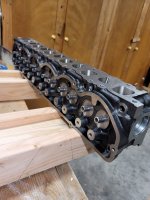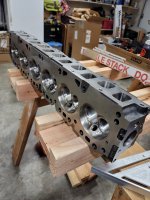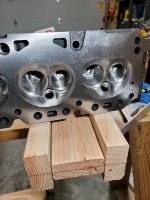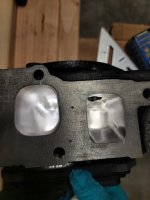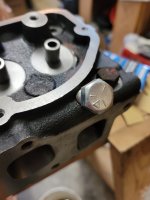You are using an out of date browser. It may not display this or other websites correctly.
You should upgrade or use an alternative browser.
You should upgrade or use an alternative browser.
'76 F250 Turbo Build
- Thread starter jgavac
- Start date
benchracer
Well-known member
He is worse than a fan dancer! Please let us see
Nice build ! Very similar to what I originally intended to do. It's kinda almost common practice to use the holset hx35 turbo on this type of build. Do you know what turbo your going to use?
I'll snag a bolt on the way home from work today and report back.I believe a 9/16-18 set screw will plug the holes in the exhaust port.
Could you get a 9/16-18 bolt and see if it screws in all the way without having to force it?
Thank you! I have been seeing the HX35 mentioned a few times, I don't currently have one picked out yet thoughNice build ! Very similar to what I originally intended to do. It's kinda almost common practice to use the holset hx35 turbo on this type of build. Do you know what turbo your going to use?
benchracer
Well-known member
thank you for view. what size valves?
1.94" intake and 1.60" exhaustthank you for view. what size valves?
9/16 is too big, I don't have a thread gauge or micrometer on hand, but since it's not 9/16 the next logical size would be 1/2-20Could you get a 9/16-18 bolt and see if it screws in all the way without having to force it?
--
Something I noticed yesterday was what appeared to be holes in 4 of the 7 head bolt pads along the manifold side. It looks like it's just a small overlap with the manifold bolt holes, likely from either cutting too large diameter or too deep. Since the manifold bolt holes are blind and not through to the water jacket, I don't forsee any issues.
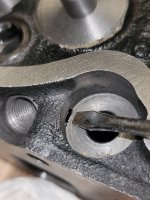
curts56
Well-known member
Supporter 2018
Gold Supporter
Supporter 2021
Supporter 2022
Supporter 2023
This is probably useless information, but the Crane roller rocker part number was 50750-12 and fit on a 3/8" stud. They are no longer available.I run the risk of getting a junk head when trying to find another used carb head, which if I have really bad luck could take more than one. Add in all the shop charges for cleaning and fluxing...
I really like the sound of the Promaxx head, the only thing I'm left figuring out now is the rocker studs, because I feel like I'm getting mixed messages. I spoke with Jason yesterday and discussed a price for doing a "bare" ported head (no valves and springs), and also the rocker machining. He wasn't sure about doing the stud machining since he hasn't done it before, but said if he had someone able to tell him exactly what needed to be done, he's open to trying it.
I also spoke with my machinist, who had a similar sentiment. His suggestion was to stick with pedestal rockers on the Promaxx head, since that was what it was set up for. He mentioned that Crane cams used to make a roller rocker with stock ratio, but I haven't been able to find anything (other than the scorpion 1.73)
Thank you for the bolt size verification.
I think the best way to plug those holes is with a set screw.
I think the best way to plug those holes is with a set screw.
9/16-18 SOCKET SET SCREW
9/16-18 SOCKET SET SCREW,(CUP POINT) ALLOY(GRADE 8),SET SCREWS ARE FULLY THREADED UNLESS NOTED,PLAIN FINISH (BLACK) AND HEX KEY SIZE IS 000.
www.allensfasteners.com
Hi there. New to forum as a non-lurker. Like the build, I'm interested to see how it goes.
Thanks, and welcome on board!
--
Feels like I'm getting down to the last couple big decisions on parts, so let's get into it;
First up, connecting rods. My machine shop was concerned about the stock rods handling the increased power. Pmuller suggested the Callies BBC rods early on, but I'm having a hard time bringing myself to spend the money on them so I think I'm going to stick with the stock rods, albeit shot peened and upgraded to ARP bolts.
Number next, rockers. I was wanting to avoid using the scorpion pedestal rockers, because I've heard mixed reviews. On the other hand, using those 1.73 rockers will help in the long run from the increased lift. So for now I'm going to return the Harland Sharpe rockers and go for scorpion.
That ties into the next question of cam lift. Using the Crower grind Pmuller shared, would I want the lobe lift reduced to bring the valve lift to match what it the 0.448/0.442 it has with 1.6 rockers? If I leave cam lift the same, I'd end up with 0.484/0.478 with the 1.73 rockers. Would this be fine?
Last things last; piston dish. Using the GoFastMath compression ratio calculator and using the cam specs from the card, a 20 cc dish piston should result in static CR 8.76 and dynamic of 7.75. The website says 8:1 is about as high as you can go on an iron head, so I don't know if the dynamic CR would be too high.
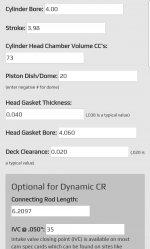
The extra valve lift by using the 1.73 ratio roller rockers will help make more torque.
For figuring the DCR for the Ford 300 six we use the advertised duration or the .006" lobe lift duration for the IVC point.
The 300 six uses a DCR range of 7.00 to 7.50 for pump gas octane of 87 to 93 at sea level for a naturally aspirated engine.
Felpro 1024 head gasket has a 4.18" bore and a .039 compressed thickness.
If you are using custom pistons you do a .010" deck clearance.
For figuring the DCR for the Ford 300 six we use the advertised duration or the .006" lobe lift duration for the IVC point.
The 300 six uses a DCR range of 7.00 to 7.50 for pump gas octane of 87 to 93 at sea level for a naturally aspirated engine.
Felpro 1024 head gasket has a 4.18" bore and a .039 compressed thickness.
If you are using custom pistons you do a .010" deck clearance.
Last edited:
Here's a brief update while on break at work; I ordered up the Crower cam and lifters early this week, and yesterday I finally pulled the trigger on Callies rods. At the same time, I ordered up the scorpion pedestal rockers, and a melling high volume oil pump.
Callies rods are not estimated to ship until mid June, so it pushes the time line back a bit, but I'm not too concerned.
In the meantime, gotta return a bunch of my earlier parts purchases. Glad summit makes it easy
Callies rods are not estimated to ship until mid June, so it pushes the time line back a bit, but I'm not too concerned.
In the meantime, gotta return a bunch of my earlier parts purchases. Glad summit makes it easy
For figuring the DCR for the Ford 300 six we use the advertised duration or the .006" lobe lift duration for the IVC point.
The 300 six uses a DCR range of 7.00 to 7.50 for pump gas octane of 87 to 93 at sea level for a naturally aspirated engine.
Felpro 1024 head gasket has a 4.18" bore and a .039 compressed thickness.
If you are using custom pistons you do a .010" deck clearance.
Revisiting this now, couple questions. The cam card you posted early on has been my reference, that was the cam I've ordered but I don't have my own card yet. In there, Crower only lists IVC at 0.050, and not at 0.006. The GoFastMath website says that with their calculator 0.006 IVC values need to be converted to 0.050 values anyway, so I wouldn't I still use the 35° IVC at 0.050?
Going with that, the felpro gasket dimensions (I had used copper gasket specs before), the new rod length with callies rods (6.385), 0.010 deck, and a piston dish of 30 CC turns back a DCR of 7.26 and a static CR of 8.21.
The DCR number is strictly a reference number we use to determine the 300 sixes tendency towards detonation and it also has relevance to the cranking compression.
We developed a DCR range of 7.0 to 7.5 for pump gas octane ranges at sea level for the 300 six based on engine build history using the .006" intake lobe closing point.
Any other lobe lift point is meaningless as far as detonation is concerned for the 300 six.
The Cam card I posted for the Crower turbo cam shows a .006" (advertised) duration of 268 degrees and a 114 degree LSA.
The .050" intake opening at -5 degrees and closing at 35 indicates the cam is to be installed 4 degrees advanced with the intake lobe center at 110 degrees ATDC.
That puts the .006" closing point at 268/2 + 110 -180 or 64 degrees ABDC.
All timing events are on the card using a little math.
So you would use 64 in the calculator to figure DCR.
The DCR should calculate as 6.6 which would be great for boost with higher cylinder temps.
The Felpro 1024 head gasket has a bore of 4.18 and a .039 compressed thickness.
We developed a DCR range of 7.0 to 7.5 for pump gas octane ranges at sea level for the 300 six based on engine build history using the .006" intake lobe closing point.
Any other lobe lift point is meaningless as far as detonation is concerned for the 300 six.
The Cam card I posted for the Crower turbo cam shows a .006" (advertised) duration of 268 degrees and a 114 degree LSA.
The .050" intake opening at -5 degrees and closing at 35 indicates the cam is to be installed 4 degrees advanced with the intake lobe center at 110 degrees ATDC.
That puts the .006" closing point at 268/2 + 110 -180 or 64 degrees ABDC.
All timing events are on the card using a little math.
So you would use 64 in the calculator to figure DCR.
The DCR should calculate as 6.6 which would be great for boost with higher cylinder temps.
The Felpro 1024 head gasket has a bore of 4.18 and a .039 compressed thickness.
Last edited:


